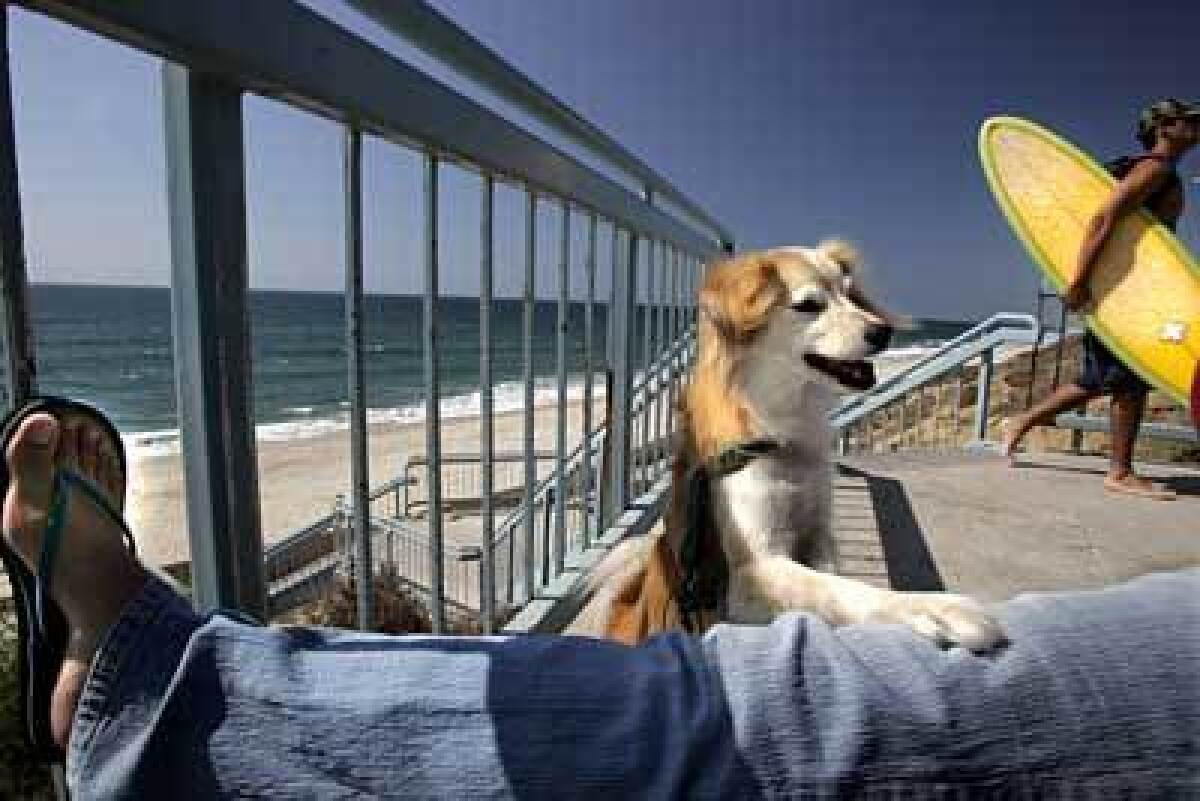So many people, they don’t have to count pets

- Share via
In 1925, residents of Carlsbad joked that their population count of 600 was achieved by including every dog and cat in town. Today, the challenge of this city of 93,000 is to maintain its quality of life. In recent years, the City Council has focused on setting aside open space and issuing guidelines to make new developments more architecturally interesting.
Beginnings
Carlsbad reflects the heritage of many cultures, starting with its original inhabitants, the Luiseno Indians. A group of explorers claimed the land in 1769 for the king of Spain. The Spanish and Indian mix gave way to Californios, followed by Anglo immigrants.
In the 1880s, John Frazier was digging a well when he struck mineral water. This spawned a small village called Frazier’s Station, which grew up around the railroad depot for the California Southern Railroad (later the Santa Fe).
Gerhard Schutte, born in Germany, purchased Frazier’s land in 1885 and promoted the water’s “healing” properties. When chemical analysis proved the water was nearly identical to the world-famous spa at Karlsbad, Bohemia, Carlsbad was officially born.
With the railroad bringing in commerce and jobs, Carlsbad grew in the 1920s. Notable buildings included the Carlsbad Hotel and Schutte’s mansion, known as one of the Twin Inns and now Neiman’s restaurant, a local landmark. The end of World War II sparked another boom in Carlsbad, and the city was incorporated in 1952.
Drawing card
Carlsbad is a charming coastal resort with small-town appeal. Its quaint downtown village has antiques stores, boutiques, sidewalk cafes and beachfront hotels. Many historic sites are in or around the village area. The city’s multicultural past is reflected in the village, traditional Latino neighborhoods and beach areas.
A vacation destination, its landscape includes seven miles of beaches and three lagoons. Legoland California, the Flower Fields and the Carlsbad Company Stores outlet mall are popular with tourists and locals.
The city is bisected by an industrial corridor and airport alongside Palomar Airport Road, which also divides the city into two postal zones. The southern half, 92009, has many tract developments as well as the custom houses of La Costa. The northern half, 92008, has the village; an area of small, well-kept homes, many still occupied by descendants of the original Latino families; and Olde Carlsbad, a neighborhood of custom houses with ocean views.
Insider’s view
Henrietta Salm, 82, moved to Carlsbad in 1961 from Indiana. “The population then was about 8,000. I remember that when my husband and I wanted to register to vote, we had to go downtown at a pornographic magazine stand, the Smoke Shop, on State Street. There have been big improvements in certain areas like the beach, and in the places to go: restaurants, parks and the like. People finally realized how great it is to be here.”
Realize it they have. “It’s a very busy time, one of the busiest for the city in terms of growth,” said Scott Donnell, an associate planner for the city. “This is the last big wave of development; even though we don’t expect build-out will occur until 2030, all of the big chunks of land will be developed between now and 2015, and then growth will slow down.”
Good news, bad news
There are plenty of new homes in the pipeline. As of August, developers had pulled permits for 1,055 homes in 2004, and many more are on tap. But more houses equal more people, and as Carlsbad’s population grows so do problems with congestion. Major thoroughfares are being built in the east, opening up the city to outside traffic.
A well-defined growth management plan mandates that 40% of the total land area remain open space. It also requires that new development pay its own way. Consequently, new home buyers pay significant Mello-Roos taxes and homeowner fees on top of mortgage payments and property tax.
Stock report
There were 317 single-family homes for sale at the end of September in the combined 92008/92009 ZIP Codes.
The median for 92008 is somewhat lower than that of 92009 because it has a greater proportion of the city’s older, generally smaller houses, which is not to say that housing anywhere in Carlsbad is inexpensive. New developments start in the mid- to high $600,000s for the smallest units.
Buyers pay a premium for homes with ocean, lagoon or canyon views.
There were 109 listings in the 92008 ZIP Code, from a three-bedroom, one-bath 1,112-square-foot house priced at $535,000 to a three-bedroom, two-bath oceanfront house at $3.8 million.
In 92009, there were 208 units available, with the lowest-priced home a two-bedroom, two-bath house listed at $530,000. At the high end of the scale, a six-bedroom, 8 1/2 -bath house was listed for $5.9 million.
Report card
On the California Department of Education “2004 Accountability Progress Report,” elementary Academic Performance Index scores ranged from 752 at Jefferson to 903 at Aviara Oaks. Scores for the two middle schools were 868 for Aviara Oaks and 798 for Valley. Carlsbad High scored 773.
Historical values
Single-family detached resales:Year...Median Price
1990...$260,0001995...$218,250
2000...$360,000
2003...$562,250
2004*...$725,000
*Year to date
Sources: San Diego Historical Society, sandiegohistory.org; Carlsbad Convention and Visitors Bureau, https://www.visitcarlsbad.com ; city of Carlsbad, https://www.carlsbad.ca.us ; https://www.in-carlsbad.com ; California Department of Education; Carlsbad Unified School District; realtor.com.
More to Read
Sign up for Essential California
The most important California stories and recommendations in your inbox every morning.
You may occasionally receive promotional content from the Los Angeles Times.






